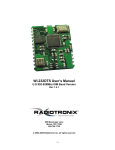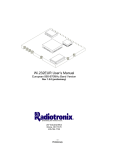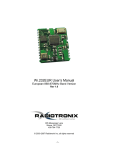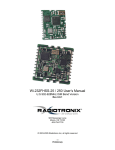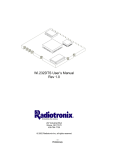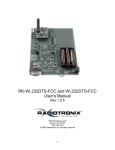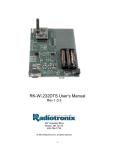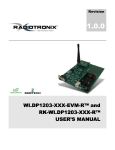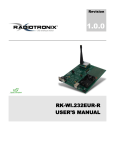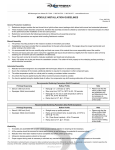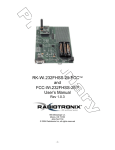Download Advantage-Devices Wi232 User`s manual
Transcript
Wi.232DTS User’s Manual
U.S 902-928MHz ISM Band Version
Rev 1.4.1
Embedding the wireless future..
207 Industrial Blvd
Moore, OK 73170
405-794-7730
© 2003-2005 Radiotronix Inc, all rights reserved
-i–
Preliminary
1. Document Control
Created By
Engineering Review
Marketing Review
Approved - Engineering
Approved - Marketing
Steve Montgomery
Revision
1.0
1.2
1.3
Author
SJM
TRM / GWH
TRM
Date
12/9/2003
5/12/2004
6/2/2004
1.3.1
TRM
6/3/2004
1.4.0
TRM
6/27/2004
1.4.1
TRM
3/15/2005
12/9/03
Description
Document Created
Various corrections including register addresses
Corrected programming omission regarding esc
chars
Corrected MAC/OUI and NVSLPMODE register
errors
Corrected inconsistencies in register tables. Altered
encoding algorithm to return size and make resultant
string null-terminated. Corrected error in Pin
Description section. Added defaults to NV register
table. Reorganized sections for better readability.
Added flash and command timing information.
Corrected error in register summary table regarding
MAC address. Renamed OUI2-0/MAC2-0 to MAC50. Updated sales information.
- ii –
Preliminary
2. Introduction
Module Overview
TRANSMITTER
BASEBAND DSP
ANTENNA SWITCH
COMBINER
UART
CONTROL
ANTENNA
VCO
PROTOCOL
CONTROLLER
2.1.
ANALOG IN
DIGITAL I/O
DATA
RECEIVER
LEGEND
HARDWARE IN WISE
Wi.232 APPLICATION
SOFTWARE IN WISE
WiSE MAC
SERIAL INTERFACE
WiSE PACKET
I/O INTERFACE
HAL
Figure 1: Wi.232DTS Block Diagram
2.2.
•
•
•
•
•
•
•
•
•
•
True UART to antenna solution
16-bit CRC error checking
152.34kbit/sec maximum RF data rate
32 channels in DTS mode
84 channels in low-power mode
Small size – .8” x .935” .08”
Low power standby and sleep modes
PHY and MAC layer protocol built in
CSMA medium access control
115dB link budget in DTS mode
2.3.
•
Features
•
•
•
•
•
•
4 modes allow user to optimize
power/range
Command mode for volatile and nonvolatile configuration
48-bit unique MAC address
5 volt tolerant I/O
Under $20 in production quantities
868MHz European version available
Applications
Direct RS-232/422/485 wire
replacement (requires external RS-232
to 3V CMOS conversion circuitry)
•
Industrial/Home Automation
•
RFID
•
Asset Tracking
•
Wireless Sensors
•
Automated Meter Reading
•
Remote Data Logging
Wi.232DTS
Preliminary
© 2003-2005 Radiotronix Inc.
Preliminary
2
Preliminary
3. Table of Contents
1.
2.
Document Control ...............................................................................................................2
Introduction..........................................................................................................................2
2.1. Module Overview .............................................................................................................. 2
2.2. Features ............................................................................................................................ 2
2.3. Applications....................................................................................................................... 2
3.
Table of Contents ................................................................................................................3
4.
Table of Figures ...................................................................................................................4
5.
Index of Tables.....................................................................................................................4
6.
Theory of Operation ............................................................................................................5
6.1. General.............................................................................................................................. 5
6.2. Operating States ............................................................................................................... 8
6.3. Resetting Module to Factory Defaults............................................................................... 9
7.
Application Information ....................................................................................................10
7.1. Pin-out Diagram .............................................................................................................. 10
7.2. Pin Description ................................................................................................................ 10
7.3. Mechanical Drawings ...................................................................................................... 11
7.4. Example Circuit ............................................................................................................... 13
7.5. Power Supply .................................................................................................................. 13
7.6. UART Interface ............................................................................................................... 13
7.7. Antenna ........................................................................................................................... 14
7.8. Link budget, transmit power, and range performance .................................................... 14
8.
Module Configuration........................................................................................................15
8.1. Channel settings ............................................................................................................. 15
8.2. Power Mode .................................................................................................................... 16
8.2.1. DTS Mode................................................................................................................ 16
8.2.2. Low power Mode...................................................................................................... 16
8.3. UART Data Rate ............................................................................................................. 17
8.4. Network Mode ................................................................................................................. 17
8.5. Transmit Wait Timeout .................................................................................................... 18
8.6. Network Group ................................................................................................................ 18
8.7. CRC Control.................................................................................................................... 18
8.8. UART minimum transmission unit................................................................................... 18
8.9. Verbose mode................................................................................................................. 19
8.10.
CSMA enable .............................................................................................................. 19
8.11.
Sleep control................................................................................................................ 19
8.12.
MAC Address .............................................................................................................. 19
8.13.
Register Summary....................................................................................................... 20
9.
Using Configuration Registers.........................................................................................20
9.1. CMD Pin .......................................................................................................................... 20
9.2. Command Formatting ..................................................................................................... 21
9.3. Writing To Registers........................................................................................................ 22
9.4. Reading From Registers ................................................................................................. 22
10.
Electrical Specifications ...................................................................................................23
10.1.
Absolute Maximum Ratings......................................................................................... 23
10.2.
Detailed Electrical Specifications ................................................................................ 23
10.2.1.
AC Specifications – RX ........................................................................................ 23
10.2.2.
AC Specifications – TX ........................................................................................ 24
10.2.3.
DC Specifications ................................................................................................. 24
10.2.4.
Flash Specifications (Non-Volatile Registers)...................................................... 25
11.
Custom Applications.........................................................................................................26
12.
Ordering Information.........................................................................................................26
13.
Contact Us..........................................................................................................................26
13.1.
Technical Support........................................................................................................ 26
13.2.
Sales Support .............................................................................................................. 26
Wi.232DTS
Preliminary
© 2003-2005 Radiotronix Inc.
Preliminary
3
Preliminary
4. Table of Figures
Figure 1: Wi.232DTS Block Diagram............................................................................................... 2
Figure 2: WiSE Block Diagram ........................................................................................................ 5
Figure 3: Wi.232DTS Networking Concept ..................................................................................... 6
Figure 4: RX State Machine ............................................................................................................ 8
Figure 5: TX State Machine............................................................................................................. 9
Figure 7: Pin-out diagram .............................................................................................................. 10
Figure 8: Module Mechanical Drawings ........................................................................................ 11
Figure 9: Wi.232DTS Suggested Footprint ................................................................................... 12
Figure 10: Evaluation Module Circuit............................................................................................. 13
Figure 11: Command and CMD Pin Timing .................................................................................. 21
Figure 12: Command Conversion Code........................................................................................ 22
5. Index of Tables
Table 1, Module Pin Descriptions.................................................................................................. 10
Table 2, Wi.232DTS UART Interface Lines................................................................................... 14
Table 3, Power Mode Register Settings ........................................................................................ 16
Table 4, DTS Mode Parameters.................................................................................................... 16
Table 5, LP Mode Parameters....................................................................................................... 17
Table 6, Data Rate Register Settings ............................................................................................ 17
Table 7, Register Summary........................................................................................................... 20
Table 8, Write Register Command, value to be written is less than 128 (0x80). .......................... 22
Table 9, Write Register Command, value to be written is greater than or equal to 128 (0x80). ... 22
Table 10, Read Register Command .............................................................................................. 22
Table 11, Read Register Module Response For A Valid Register ................................................ 22
Table 12, Absolute Maximum Ratings........................................................................................... 23
Table 13, AC Specifications - Rx................................................................................................... 23
Table 14, AC Specifications - Tx ................................................................................................... 24
Table 15, DC Specifications .......................................................................................................... 24
Table 16, Flash Specifications (Non-Volatile Registers) ............................................................... 25
Wi.232DTS
Preliminary
© 2003-2005 Radiotronix Inc.
Preliminary
4
Preliminary
6. Theory of Operation
6.1.
General
The Wi.232 module is one of a family of WiSE™ (Wireless Serial Engine) modules. A WiSE™
module combines a state-of-the-art DTS/FSK data transceiver and a high-performance protocol
controller to create a complete embedded wireless communications link in a tiny IC-style
package.
Figure 2: WiSE Block Diagram
The Wi.232DTS module has a UART-type serial interface and contains special application
software to create a transparent UART-to-antenna wireless solution capable of direct wire
replacement in most embedded RS-232/422/485 applications.
NOTE: Although the module is capable of supporting the typical serial communications required
by RS-232, RS-422, and RS-485 networks, it is not compatible with the electrical interfaces for
these types of networks. The module has CMOS inputs and outputs and would require an
appropriate converter for the particular type of network it is connected to.
Wi.232DTS
Preliminary
© 2003-2005 Radiotronix Inc.
Preliminary
5
Preliminary
Figure 3: Wi.232DTS Networking Concept
The module is designed to interface directly to a host UART. Three signals are used to transfer
data between the module and the host UART: TXD, RXD, and CTS. TXD is the data output from
the module RXD is the data input to the module. CTS is an output that indicates the status of the
module’s data interface. If CTS is low, the module is ready to accept data. If CTS is high, the
module is busy and the host UART should not send any further data.
Internally, the module has a 192 byte buffer for incoming characters from the host UART. The
module can be programmed to automatically transmit when the buffer reaches a programmed
limit, set by regUARTMTU. The module can also be programmed to transmit based on
a delay between characters, set by regTXTO(set in 1mSec increments). These registers allow
the designer to optimize performance of the module for fixed length and variable length data. The
module will support streaming data, as well. To optimize the module for streaming data,
regUARTMTU should be set to 128, and regTXTO should be set to a value equal to 1 byte time
at the current UART data rate. If the buffer is full, or the timer set by regTXTO expires, and the
module is in the process of sending the previous packet over the RF link, the module will assert
CTS high, indicating that the host should not send any more data. Data sent by the host while
CTS is high will be lost.
When the MAC layer has a packet to send, it will use a carrier-sense-multiple-access (CSMA)
protocol to determine if another module is already transmitting. If another module is transmitting,
the module will receive that data before attempting to transmit its data again. If, during this
process, the UART receive buffer gets full, the CTS line will go high to prevent the host UART
from over-running the receive buffer. The CSMA mechanism introduces a variable delay to the
transmission channel. This delay is the sum of a random period and a weighted period that is
dependent on the number of times that the module has tried and failed to acquire the channel.
For applications that guarantee that only one module will be transmitting at any given time, the
CSMA mechanism can be turned off to avoid this delay.
The MAC layer prefixes the data with a packet header and postfixes the data with a 16-bit CRC.
The 16-bit CRC error checking can be disabled to allow the application to do its own error
Wi.232DTS
Preliminary
© 2003-2005 Radiotronix Inc.
Preliminary
6
Preliminary
checking. Data is encoded using a proprietary algorithm (DirectSPREAD™) to spread the RF
energy equally within the transmission bandwidth.
Modules can operate in groups. Each module can be assigned an 8-bit group ID, which is used
to logically link it to other modules on the same channel. All modules on a channel will
interoperate, regardless of their respective group Ids. In other words, the CSMA mechanism will
prevent collisions of modules on the same channel but belonging to different groups.
Modules can also operate in two network modes: Master/Slave and Peer-to-Peer. These modes
define a set of communication rules that identifies which modules can talk to any given module.
In Master/Slave mode, masters can talk to slaves and other masters, slaves can talk to masters,
but slaves cannot talk to other slaves. This mode is sometimes required for applications that are
replacing legacy RS-485 networks. In peer-to-peer mode, any module can hear any other
module. In both modes, group integrity is enforced.
When a module transmits a packet, all other modules on the same channel will receive the
packet, check the packet for errors, and determine whether the received group ID matches the
local group ID. If the packet is error free and the group Ids match, the module will decrypt the
data if necessary, and send the error free data to its host UART for processing. The modules
only implement the ISO reference network stack up to the MAC layer, so they are transparent to
link layer addressing schemes. Therefore, the modules can work with any link-layer and higher
protocols in existing today.
Certain features of the module are controlled through programmable registers. Registers are
access by bringing CMD low. When CMD is low, all data transfers from the host UART are
considered to be register access commands. When CMD is high, all data transfers from the host
UART are considered to be raw data that needs to be transparently transmitted across the
wireless link. The module maintains two copies of each register: one in flash and one in RAM.
On reset, the module loads the RAM registers from the values in the flash registers. The module
is operated out of the RAM registers. Applications that need to change parameters of the module
often would simply modify the RAM register. By putting default settings in the flash registers, the
module will always come up in a preconfigured state, which is useful for applications that do not
have external microcontrollers, such as RS-232 adapters.
The UART interface is capable of operating in full duplex at baud rates from 2.4 to 115.2 kbps.
The module has six power modes: High DTS, Medium DTS, Low DTS, low power, standby, and
sleep.
The Wi.232DTS module is the first module in the world to take advantage of the digital spread
spectrum provision in FCC part 15 rules. Under this provision, transmitters can operate at a
higher output power if the transmission bandwidth is at least 500kHz. Through an encoding
technique we call DirectSPREAD™, the Wi.232DTS module is able to operate at +11dBm and
meet the requirements of this provision.
In DTS mode, the module’s channel bandwidth is set to 600kHz and the transmit power is set to
+11dBm. In this mode, the module can operate on 32 channels and support a maximum RF data
rate of 152.34kbit/second. The receiver sensitivity at the max data rate is –100dBm typical,
yielding a link budget of 111dB. This mode is an excellent alternative to frequency hopping
spread spectrum. It has very fast synchronization, allowing it to operate in a duty-cycle mode for
extended battery life.
In low-power mode, the module’s channel bandwidth is set to 200kHz and the transmit power is
set to 0dBm. In this mode, the module can operate on 84 channels and support a maximum data
rate of 38.4 kbit/second. The receiver sensitivity at the maximum data rate is –105 typical,
yielding a link budget of 105dB. This mode reduces transmit current consumption, allowing use
Wi.232DTS
Preliminary
© 2003-2005 Radiotronix Inc.
Preliminary
7
Preliminary
with batteries than cannot supply the pulse currents required for DTS mode. The range in this
mode will be a little more than half of the range in DTS mode.
The module can be placed into sleep mode through the command mode. In sleep mode, the RF
section is completely shutdown, and the protocol processor is in an idle state. Once the module
has been placed in the sleep mode, it can be awaken by either cycling power, which will loose all
volatile settings, or by sending a power-up sequence through the serial port. The power up
sequence is a combination of four 0xFF bytes sent back-to-back at the data rate for which the
module is configured.
Note: When in sleep mode, the module will not be able to receive data from other modules. Any
data sent to the module while it is in sleep mode will be lost.
If the current draw in sleep mode is too high for a particular application, the designer can switch
power to the module through a FET to “turn-off” the module when it is not needed. If this
technique is used, the volatile registers will reset to the values in their non-volatile mirrors, so any
changes from the default will have to be reloaded.
The Wi.232DTS is a very flexible module because of all of the configurable parameters it
supports. However, modules that are not configured in the same way will not be able to
communicate reliably, causing poor performance or outright failure of the wireless link. All
modules in a network must have the same mode configuration to ensure interoperability.
Every Wi.232 module has read-only internal registers that contain factory programmed
information that includes calibration data and a 48-bit MAC address that can be used by the host
application for higher level, connection oriented protocols. This MAC address can be read
through the command interface.
6.2.
Operating States
The primary active state is the IDLE state. When the module is not actively transmitting or
receiving data, it is in this state. While in this state, the receiver is enabled and the module is
continuously listening for incoming data. If the module detects a pre-amble and valid start-code,
it will enter the RX_HEADER state.
IS R
RF
E O U T
R X T IM
R X H E A D E R
HE
R X D A T A
AD
ER
ID L E M O D E
OK
D A T A LE N <M T U
RX
DO
NE
CR
PA
B
C-
E
CK
AD
T
Q
UE
D
RFIS
R
C R C
U A R T T X
Figure 4: RX State Machine
If the module is in the IDLE state and a byte is received by the UART, it will enter the TX_WAIT
state.
Wi.232DTS
Preliminary
© 2003-2005 Radiotronix Inc.
Preliminary
8
Preliminary
RX HEADER
RF
U
MT
N=
E
L R UT
TA O EO
M
DA
TI
TX
X
TR
UAR
IS
R
IDLE MODE
DATALEN<MTU
TX WAIT
TE
PLE
COM
TX
CSMA
Figure 5: TX State Machine
6.3.
Resetting Module to Factory Defaults
It may be necessary to reset the non-volatile registers to their factory defaults. To reset the
module to factory defaults, hold the command line low and cycle power to the module. The
command line must remain low for a minimum of 450ms after the resetting the module. Once the
command line is released, the module’s non-volatile registers will be reset to factory defaults.
Wi.232DTS
Preliminary
© 2003-2005 Radiotronix Inc.
Preliminary
9
Preliminary
7. Application Information
7.1.
Pin-out Diagram
Figure 7: Pin-out diagram
7.2.
No.
1
2
3
4
5
6
7
8
9
10
11
12
13
14
15
16
17
18
19
Pin Description
Description
Ground
No connect – reserved
No connect – reserved
Command input – active low
UART receive input
UART transmit output
UART clear to send output – active
low
No connect – reserved
No connect – reserved
Reserved – ISP pin
Reserved – ISP pin
Ground
Antenna port – 50 ohm
Ground
Ground
Ground
Ground
Ground
VCC – 2.7 to 3.6 VDC
Table 1, Module Pin Descriptions
Legend
Signals that are used in this implementation
Signals not used in this implementation –do not connect
Signals used for in-system programming
Wi.232DTS
Preliminary
© 2003-2005 Radiotronix Inc.
Preliminary
10
Preliminary
7.3.
Mechanical Drawings
Figure 8: Module Mechanical Drawings
Wi.232DTS
Preliminary
© 2003-2005 Radiotronix Inc.
Preliminary
11
Preliminary
Figure 9: Wi.232DTS Suggested Footprint
Wi.232DTS
Preliminary
© 2003-2005 Radiotronix Inc.
Preliminary
12
Preliminary
7.4.
Example Circuit
Figure 10: Evaluation Module Circuit
7.5.
Power Supply
Although the Wi.232DTS module is very easy to use, care must be given to the design of the
power supply circuit. It is important for the power supply to be free of digital noise generated by
other parts of the application circuit, such as the RS-232 converter.
Figure 4 shows the schematic for our evaluation module circuit for the Wi.232DTS module. It
includes an on-board power supply and antenna connector. This evaluation circuit was used to
measure the performance of the Wi.232DTS module, and should be used as a reference for
Wi.232DTS based designs.
If noise is a problem, it can usually be eliminated by using a dedicated LDO regulator for the
module and/or by separating the grounds for the module and the other circuits.
7.6.
UART Interface
The UART interface is very simple; it is comprised of four CMOS compatible digital lines.
Wi.232DTS
Preliminary
© 2003-2005 Radiotronix Inc.
Preliminary
13
Preliminary
Line
Direction
Description
CTS
Out
Clear to send – this pin indicates to the host micro when it is ok to send data.
When CTS is high, the host micro should stop sending data to the module until
CTS returns to the low state.
CMD
In
Command – the host micro will bring this pin low to put the module in
command mode. Command mode is used to set and read the internal
registers that control the operation of the module. When CMD is high,
the module will transparently transfer data to and from other modules
on the same channel.
RXD
TXD
In
Out
NOTE: If this pin is low when the module comes out of reset, the registers will
be reset to their factory programmed defaults. It is important to ensure that
CMD is held high during power-up under normal conditions.
Receive data input.
Transmit data output
Table 2, Wi.232DTS UART Interface Lines
7.7.
Antenna
The module is designed to work with any 50-ohm antenna, including PCB trace antennas.
We are often asked: “ What is the best antenna to use with your module?” Actually, the selection
of an antenna is based on a particular application, not the module used.
As a rule, a ¼ wave whip antenna with a good, solid ground plane is the best choice. However,
many embedded applications cannot support an externally mounted antenna. If this is the case,
a PCB antenna must be used. The designer can either use an off-of-the-shelf PCB antenna,
such as the Splatch from Linx Technologies, or design a trace antenna. There are several good
antenna tutorials and references on the Internet and we encourage the designer to use these
resources.
Note: Antenna design is difficult and can be impossible without the proper test equipment. As
such, we strongly encourage all of our customers to use off-of-the-shelf antennas whenever
possible.
7.8.
Link budget, transmit power, and range performance
A link budget is the best figure of merit for comparing wireless solutions and determining how
they will perform in the field.
In general, the solution with the best link budget will deliver the best line-of-sight range
performance. Improving the link budget by increasing the receiver sensitivity will result in lower
power consumption while improving the link budget by increasing the transmit power will result in
more robust performance in the presence of an on-channel interferer or multi-path interference.
Wireless Fact: You will never reduce the performance of a wireless link by increasing the
sensitivity.
It has been proposed that less sensitive receivers will perform better in a noisy environment. That
simply is not true. It is the equivalent of saying that someone who is hard of hearing can hear
better in a noisy room than in a quiet room. The real solution is to make the talker speak louder
to get over the noise in the room. The same is true for a wireless link. In real-world, noisy
environments, increased output power is generally the best way to improve range performance.
The transmit power on unlicensed devices is regulated by the FCC. For transmitters that are not
spread-spectrum, the output power is limited to 0dBm (1mW) when a standard ¼ wave whip
Wi.232DTS
Preliminary
© 2003-2005 Radiotronix Inc.
Preliminary
14
Preliminary
antenna is used. If the transmitter operates under the spread-spectrum rules, however, the
transmit power can be increased; up to 1W depending on the spread-spectrum technique and
antennas that are used.
Wireless Fact: Frequency hopping spread spectrum does not effectively combat multipath in the
902-928 MHz band. It does combat in-channel interference, but at the expense of bandwidth,
power consumption, and latency. Direct sequence spread spectrum, like FHSS, does not combat
multipath. It does do a better job than FHSS at combating in-channel interference, but at the
expensive of occupied bandwidth and power consumption. These spread spectrum techniques
are generally chosen because the FCC will allow higher output power from a transmitter
employing these techniques. Recently, the FCC rules changed to include a new type of spread
spectrum device, call digital transmission system (DTS). This method of spread spectrum has no
processing gain, but allows lower cost solutions like the Wi.232DTS to transmit with higher output
power.
To calculate the link budget for a wireless link, simply add the transmit power, the antenna gains,
and the receiver sensitivity:
LB = Ptx + Gtxa − SENSrx + Grxa
For example, the link budget for a pair of Wi.232 modules in DTS mode at the maximum data rate
and using 3dBi whips antennas would be:
+11dBm + 3dB – (-100dBm) + 3dB = 117dB
A link budget of 117dB should easily yield a range of ¼ mile or more outdoors. If the environment
is open and the antennas are 8 to 10 feet off of the ground, the range could be a mile. Indoors,
this link budget should yield a range of several hundred feet.
This is a well-balanced link budget. More than 10dB of the budget is achieved through transmit
power, which will allow good performance indoors in the presence of multi-path while keeping the
overall operating current low, making the module suitable for primary battery powered
applications such as RFID and automated meter reading.
8. Module Configuration
8.1.
Channel settings
regNVTXCHAN (0x00)
R/W
R/W
R/W
RES
D6
D5
7
6
5
R/W
D4
4
R/W
D3
3
R/W
D2
2
regTXCHAN (0x4B)
R/W
R/W
D1
D0
1
0
regNVRXCHAN (0x01)
R/W
R/W
R/W
RES
D6
D5
7
6
5
R/W
D4
4
R/W
D3
3
R/W
D2
2
regRXCHAN (0x4C)
R/W
R/W
D1
D0
1
0
The Wi.232DTS supports 32 channels (0 – 31) in DTS mode and 84 channels (0 – 83) in low
power mode.
Transmit and receive channels are set in regTXCHAN (addr 0x4B) and regRXCHAN (addr
0x4C) respectively.
Wi.232DTS
Preliminary
© 2003-2005 Radiotronix Inc.
Preliminary
15
Preliminary
When the module is in DTS mode, the channel registers are masked so that only the lower 6-bits
determine the channel.
The following equations can be used to calculate transmit center frequency in LP and DTS
modes.
Fc = 902.3 + chan * .3MHz( LP)
Fc = 903.0 + chan * .75MHz( DTS )
All modules in a network must be in the same mode (LP or DTS) and must have the same
transmit and receive channels programmed in order to communicate properly.
8.2.
Power Mode
The transmission and reception modes of the module are determined by the settings of the
regPWRMODE register. It is important to note that a module configured to operate in LP mode
cannot “hear” another module transmitting in DTS mode, or vice versa. However, a module
configured to operate in any of the three DTS modes can “hear” any other module transmitting in
any of the DTS modes (provided that they are within range of one another).
regNVPWRMODE (0x02)
R/W
R/W
R/W
NA
NA
NA
7
6
5
PM1
0
0
1
1
PM0
0
1
0
1
R/W
NA
4
R/W
NA
3
regPWRMODE (0x4D)
R/W
R/W
R/W
NA
PM1
PM0
2
1
0
Mode
LP Mode – -5dBm power setting (typical)
DTS Mode – -1dBm power setting (typical)
DTS Mode – +2dBm power setting (typical)
DTS Mode – +11dBm power setting (typical)
Table 3, Power Mode Register Settings
8.2.1. DTS Mode
In DTS mode, the module is configured as follows:
DTS Mode Parameters
TX Power
-1, +2, or +11 dBm
Deviation
+/-235kHz
TX Current
28 to 57mA
RX Current
20mA
RX Bandwidth
600kHz
Table 4, DTS Mode Parameters
8.2.2. Low power Mode
In low-power mode, the module is configured as follows:
Wi.232DTS
Preliminary
© 2003-2005 Radiotronix Inc.
Preliminary
16
Preliminary
LP Mode Parameters
TX Power
-3.5dBm
Deviation
+/-50kHz
TX Current
24mA
RX Current
20mA
RX Bandwidth
200kHz
Table 5, LP Mode Parameters
8.3.
UART Data Rate
regNVDATARATE (0x03)
R/W
R/W
R/W
RES
RES
RES
7
6
5
R/W
RES
4
R/W
RES
3
regDATARATE (0x4E)
R/W
R/W
R/W
BR2
BR1
BR0
2
1
0
By default, the UART data rate is set to 2.4 kbit/second at the factory. This data rate can be
changed by setting the regDATARATE register. Valid settings are:
Baud Rate
2400
9600
19200
38400
57600
115200
BR2
0
0
0
0
1
1
BR1
0
0
1
1
0
0
BR0
0
1
0
1
0
1
Table 6, Data Rate Register Settings
TROUBLESHOOTING HINT: Baud Rate Problems. If you lose track of the baud rate setting of
the module, it will be impossible to program the module. You can either try every possible baud
rate to discover the setting, or force a power-on reset with CMD held low to set the baud rate to
its default: 2.4kbit/second.
8.4.
Network Mode
regNVNETMODE (0x04)
R/W
R/W
R/W
D7
D6
D5
7
6
5
R/W
D4
4
R/W
D3
3
regNETMODE (0x4F)
R/W
R/W
R/W
D2
D1
D0
2
1
0
The module supports two networking modes: Normal and Slave.
In normal mode, the module can talk to any other module. In slave mode, the module can talk to
normal-mode modules, but cannot transmit to or receive from other slaves.
Slave mode is selected by writing 0x00 to this register. The default network mode is 0x01
(Normal Mode).
Wi.232DTS
Preliminary
© 2003-2005 Radiotronix Inc.
Preliminary
17
Preliminary
8.5.
R/W
D7
7
Transmit Wait Timeout
regNVTXTO (0x05)
R/W
R/W
D6
D5
6
5
R/W
D4
4
R/W
D3
3
R/W
D2
2
regTXTO (0x50)
R/W
R/W
D1
D0
1
0
When a byte is received by the UART, the module will start a timer that will countdown every
millisecond. The timer is restarted when each byte is received.
If the timer reaches zero before the next byte is received from the UART, the module begin
transmitting the data in the buffer. Normally, this timeout value should be greater than 0x01 and
greater than one byte time at the current UART data rate. If the timeout value is set to 0x00, the
transmit wait timeout will not operate, and a full buffer will be required for transmission. When
setup this way, the data will be sent only when a full MTU has been received through the UART.
The default setting for this register is 0x10 (~16ms delay).
8.6.
Network Group
regNVNETGRP (0x06)
R/W
R/W
R/W
B7
B6
B5
7
6
5
R/W
B4
4
R/W
B3
3
R/W
B2
2
regNETGRP (0x51)
R/W
R/W
B1
B0
1
0
Modules can be grouped into networks. Although only modules with the group ID will be able to
talk to each other, modules in different groups but on the same channel will still coordinate
transmissions through the CDMA mechanism. Valid values for this register are 0 to 127. The
default group setting is 0.
8.7.
CRC Control
regNVUSECRC (0x08)
R/W
R/W
R/W
B7
B6
B5
7
6
5
R/W
B4
4
R/W
B3
3
R/W
B2
2
regUSECRC (0x53)
R/W
R/W
B1
B0
1
0
Set to 0x01 to enable CRC mode, or 0x00 to disable CRC mode. The default CRC mode setting
is enabled.
8.8.
UART minimum transmission unit
regNVUARTMTU (0x09)
R/W
R/W
R/W
B7
B6
B5
7
6
5
R/W
B4
4
R/W
B3
3
regUARTMTU (0x54)
R/W
R/W
R/W
B2
B1
B0
2
1
0
This register determines the UART buffer level that will trigger the transmission of a packet. The
minimum value is 1 and the maximum value is 128. The default value for this register is 64,
which provides a good mix of throughput and latency.
Wi.232DTS
Preliminary
© 2003-2005 Radiotronix Inc.
Preliminary
18
Preliminary
8.9.
Verbose mode
regNVSHOWVER (0x0A)
R/W
R/W
R/W
B7
B6
B5
7
6
5
R/W
B4
4
R/W
B3
3
regSHOWVER (0x55)
R/W
R/W
R/W
B2
B1
B0
2
1
0
Setting this register to 0x00 will suppress the start-up message, including firmware version, that is
sent to the UART when the module is reset. A value of 0x01 will cause the message to be
displayed after reset. By default, the module start-up message will be displayed.
8.10. CSMA enable
regNVCSMAMODE (0x0B)
R/W
R/W
R/W
B7
B6
B5
7
6
5
R/W
B4
4
R/W
B3
3
regCSMAMODE (0x56)
R/W
R/W
R/W
B2
B1
B0
2
1
0
Carrier-sense multiple access (CSMA) is a best-effort delivery system that listens to the channel
before transmitting a message. If another Wi.232 module is already transmitting when a
message is queued, the module will wait before sending its payload. This helps to eliminate RF
message corruption at the expense of additional latency. Setting this register to 0x01 will enable
CSMA. Setting this register to 0x00 will disable CSMA. By default, CSMA is enabled.
8.11. Sleep control
regNVSLPMODE (0x0D)
R/W
R/W
R/W
B7
B6
B5
7
6
5
R/W
B4
4
R/W
B3
3
regSLPMODE (0x58)
R/W
R/W
R/W
B2
B1
B0
2
1
0
Setting this register to 0x01 will place the module into sleep mode; 0x02 will place the module in
standby mode. Sleep mode places the module in the lowest power inactive state (~100µA) and
requires approximately 7-8ms to resume transmission or reception once awakened. Standby
draws ~850µA and requires approximately 1-2ms to awaken. To wake up the module, send four
0xFF bytes to the UART in a row or perform a hard reset. If four 0xFF bytes are used to wake the
module, the fifth character sent to the UART will be transmitted over the RF link. Upon
awakening, the module will clear the volatile register to 0x00. The default value for this register is
0x00 (awake).
8.12. MAC Address
regMAC5 – regMAC0 (0x22 – 0x27)
R
R
R
D7
D6
D5
7
6
5
R
D4
4
R
D3
3
R
D2
2
N/A
R
D1
1
R
D0
0
These registers make a unique 48-bit MAC address. These values are factory preset and cannot
be altered. These address bytes are not used by the module. They are provided for customer
applications as a unique address.
Wi.232DTS
Preliminary
© 2003-2005 Radiotronix Inc.
Preliminary
19
Preliminary
8.13. Register Summary
Name
regTXCHANNEL
regRXCHANNEL
regPWRMODE
regDATARATE
regNETMODE
regTXTO
regNETGRP
regUSECRC
regUARTMTU
regSHOWVER
regCSMAMODE
regSLPMODE
Name
regMAC5
regMAC4
regMAC3
regMAC2
regMAC1
regMAC0
Name
regNVTXCHANNEL
regNVRXCHANNEL
regNVPWRMODE
regNVDATARATE
regNVNETMODE
regNVTXTO
regNVNETGRP
regNVUSECRC
regNVUARTMTU
regNVSHOWVER
regNVCSMAMODE
regNVSLPMODE
Volatile Read/Write Registers
Address
Description
0x4B
Transmit channel setting
0x4C
Receive channel setting
0x4D
Operating mode settings
0x4E
UART data rate
0x4F
Network mode (Normal or Slave)
0x50
Transmit wait timeout
0x51
Network group ID
0x53
Enable/Disable CRC
0x54
Minimum transmission unit.
0x55
Enable/disable start-up message
0x56
Enable/disable CSMA
0x58
Power state of module
Non-volatile Read Only Registers
Address
Description
0x22
These registers form the unique 48-bit MAC address.
0x23
0x24
0x25
0x26
0x27
Non-volatile Registers
Address
Description
Default
0x00
Transmit channel setting
16
0x01
Receive channel setting
16
0x02
Operating mode settings
-1 dBm DTS mode
0x03
UART data rate
2400bps
0x04
Network mode (Normal/Slave)
Normal
0x05
Transmit wait timeout
~16ms
0x06
Network group ID
0x00
0x08
Enable/Disable CRC
Enabled
0x09
Minimum transmission unit.
64 bytes
0x0A
Enable/Disable start-up message
Enabled
0x0B
Enable/Disable CSMA
Enabled
0x0D
Power state of module
Awake
Table 7, Register Summary
9. Using Configuration Registers
9.1.
CMD Pin
The CMD pin is used to inform the module where incoming UART information should be routed.
When the CMD pin is high or left floating, all incoming UART information is treated as payload
data and transferred over the wireless interface. If the CMD pin is low, the incoming UART data
is routed to the command parser for processing. Since the module’s processor looks at UART
data one byte at a time, the CMD line must be held low for the entire duration of the command
plus a 20µs margin for processing. Leaving the CMD pin low for additional time (for example,
until the ACK byte is received by your application) will not adversely affect the module. If RF
Wi.232DTS
Preliminary
© 2003-2005 Radiotronix Inc.
Preliminary
20
Preliminary
packets are received while the CMD line is active, they are still processed and presented to the
module’s UART for transmission.
Figure 11: Command and CMD Pin Timing
9.2.
Command Formatting
The Wi.232DTS module contains several volatile and non-volatile registers that control its
configuration and operation. The volatile registers all have a non-volatile mirror register that is
used to determine the default configuration when power is applied to the module. During normal
operation, the volatile registers are used to control the module.
Placing the module in the command mode allows these registers to be programmed. Byte values
in excess of 127 (0x80 or greater) must be changed into a two-byte escape sequence of the
format: 0xFE, [value - 128]. For example, the value 0x83 becomes 0xFE, 0x03. The following
function will prepend a 0xFF header and size specifier to a command sequence and create
escape sequences as needed. It is assumed that *src is populated with either the register
number to read (one byte, pass 1 into src_len) or the register number and value to write (two
bytes, pass 2 into src_len). It is also assumed that the *dest buffer has enough space for the
two header characters plus, the encoded command, and the null terminator.
int EscapeString(char *src, char src_len, char *dest)
{
// The following function copies and encodes the first
// src_len characters from *src into *dest. This
// encoding is necessary for Wi.232 command formats.
// The resulting string is null terminated. The size
// of this string is the function return value.
// --------------------------------------------------char src_idx, dest_idx;
// Save space for the command header and size bytes
// -----------------------------------------------dest_idx = 2;
// Loop through source string and copy/encode
// -----------------------------------------for (src_idx = 0; src_idx < src_len; src_idx++)
{
if (src[src_idx] > 127)
{
dest[dest_idx++] = 0xFE;
}/*if*/
dest[dest_idx++] = (src[src_idx] & 0x7F);
}/*for*/
// Add null terminator
// ------------------dest[dest_idx] = 0;
// Add command header
// -----------------dest[0] = 0xFF;
dest[1] = dest_idx – 2;
// Return escape string size
// ------------------------return dest_idx;
}
Wi.232DTS
Preliminary
© 2003-2005 Radiotronix Inc.
Preliminary
21
Preliminary
Figure 12: Command Conversion Code
9.3.
Writing To Registers
Writing to a volatile register is nearly instantaneous. Writing to a non-volatile register, however,
takes typically 16 ms. Because the packet size can vary based on the need for encoding, there
are two possible packet structures. The following tables show the byte sequences for writing a
register in each case.
WARNING: Be sure that the module is properly powered and remains powered for the duration of
the register write. Loss of important configuration information could occur if the unit loses power
during a non-volatile write cycle.
Byte 0
Byte 1
Byte 2
Byte 3
Header
Size
Register
Value
7 6 5 4 3 2 1 0 7 6 5 4 3 2 1 0 7 6 5 4 3 2 1 0 7 6 5 4 3 2 1 0
0xFF
0x02
0 Register 0
Value
Table 8, Write Register Command, value to be written is less than 128 (0x80).
Byte 0
Byte 1
Byte 2
Byte 3
Byte 4
Header
Size
Register
Escape
Value
7 6 5 4 3 2 1 0 7 6 5 4 3 2 1 0 7 6 5 4 3 2 1 0 7 6 5 4 3 2 1 0 7 6 5 4 3 2 1 0
Lower 7 bits
of Value
Table 9, Write Register Command, value to be written is greater than or equal to 128 (0x80).
0xFF
0x03
0
Register
0xFE
0
The module will respond to this command with an ACK (0x06). If an ACK is not received, the
command should be resent. If a write is attempted to a read-only or invalid register, the module
will respond with a NAK (0x15).
9.4.
Reading From Registers
A register read command is constructed by placing an escape character before the register
number. The following table shows the byte sequence for reading a register.
Byte 0
Byte 1
Byte 2
Byte 3
Header
Size
Escape
Register
7 6 5 4 3 2 1 0 7 6 5 4 3 2 1 0 7 6 5 4 3 2 1 0 7 6 5 4 3 2 1 0
0xFF
0x02
Table 10, Read Register Command
0xFE
0
Register
The module will respond to this command by sending an ACK (0x06) followed by the register
number and register value. The register value is sent unmodified. For example, if the register
value is 0x83, 0x83 is returned after the ACK (0x06). See table below for the format of the
response. If the register number is invalid, it will respond with a NACK (0x15).
Byte 0
Byte 1
Byte 2
ACK
Register
Value
7 6 5 4 3 2 1 0 7 6 5 4 3 2 1 0 7 6 5 4 3 2 1 0
0x06
0 Register
Value
Table 11, Read Register Module Response For A Valid Register
Wi.232DTS
Preliminary
© 2003-2005 Radiotronix Inc.
Preliminary
22
Preliminary
10.
Electrical Specifications
10.1. Absolute Maximum Ratings
Parameter
VCC – Power Supply
Voltage on any pin
Input RF Level
Storage Temperature
Min
Max
Units
-0.3
-0.3
5.0
5.2
15
85
VDC
VDC
dBm
°C
-40
Table 12, Absolute Maximum Ratings
10.2. Detailed Electrical Specifications
10.2.1.
AC Specifications – RX
Parameter
Receive frequency - US
Min
Typ
902.2
Max
Units
Notes
927.8
MHz
At antenna pin
Channels – DTS
32
Channels – LP Mode
84
Channel spacing – DTS Mode
750
kHz
Channel spacing – LP Mode
300
kHz
Receiver sensitivity – DTS MODE
-100
dBm
152.34 kbit/sec
Receiver sensitivity – DTS MODE
-102
dBm
38.4 kbit/sec
Receiver sensitivity – DTS MODE
-104
dBm
9.6 kbit/sec
Receiver sensitivity – LP MODE
-104
dBm
38.4 kbit/sec
Receiver sensitivity – LP MODE
-105
dBm
9.6 kbit/sec
Input IP3
-40
dBm
Flo+1MHz and
Flo+1.945MHz
Input Impedance
50
Ohms
No matching required
LO Leakage
-65
dBm
50-ohm termination at
ANT
Adjacent channel rejection
-48
dBc
Fc +/-650kHz
dBc
IF Bandwidth – DTS Mode
600
KHz
IF Bandwidth – LP Mode
200
KHz
Table 13, AC Specifications - Rx
Wi.232DTS
Preliminary
© 2003-2005 Radiotronix Inc.
Preliminary
23
Preliminary
10.2.2.
AC Specifications – TX
Parameter
Min
Transmit Frequency –US
902.2
Typ
Max
Units
927.8
MHz
3
ppm
Notes
Center frequency error
2
915 MHz @ 25°C
Frequency Deviation – DTS Mode
+/-235
kHz
Frequency Deviation – LP Mode
+/-50
kHz
Maximum Output Power – LP
Mode
Maximum Output Power – DTS
Mode
Output Impedance
-5
0
dBm
11
14
dBm
50
Ohms
Carrier phase noise
TBD
dBc
Into 50 ohm load
Harmonic Output
-50
dBc
Into 50 ohm load
915 MHz
Into 50 ohm load
915 MHz
Into 50 ohm load
Table 14, AC Specifications - Tx
10.2.3.
DC Specifications
Parameter
Operating Temperature
Min
-20
Typ.
Max
+70
Units
°C
Notes
Supply voltage
2.7
3.0
3.6
VDC
Operating limits
20
mA
Continuous operation,
Vdd = 3.3VDC
LP Mode – -5 dBm
DTS Mode – -1 dBm
DTS Mode – 2 dBm
DTS Mode – 11 dBm
Standby current consumption
28
32
39
57
850
mA
mA
mA
mA
µA
Vdd = 3.3VDC
Sleep current consumption
100
µA
Vdd = 3.3VDC
Receive current consumption
Transmit current consumption
Vih – Logic high level input
Vil – Logic low level input
Voh – Logic high level output
Vol – Logic low level output
0.7*Vcc
0
2.5
0
5.2
0.3*Vc
c
Vcc
.4
Output into 50 ohm load,
Vdd = 3.3VDC
VDC
VDC
VDC
VDC
Table 15, DC Specifications
Wi.232DTS
Preliminary
© 2003-2005 Radiotronix Inc.
Preliminary
24
Preliminary
10.3. Flash Specifications (Non-Volatile Registers)
Parameter
Flash Write Duration
Min
Typ.
16
Flash Write Cycles
20k
100k
Max
21
Units
ms
Notes
Module stalled during
write operation
Cycles
Table 16, Flash Specifications (Non-Volatile Registers)
Wi.232DTS
Preliminary
© 2003-2005 Radiotronix Inc.
Preliminary
25
Preliminary
11.
Custom Applications
For cost-sensitive applications, such as wireless sensors and AMR, Radiotronix can embed the
application software directly into the microcontroller built into the module. For more information
on this service, please contact Radiotronix.
12.
Ordering Information
Wi.232DTS modules can be ordered on-line 24/7 from Mouser Electronics at
www.mouser.com/radiotronix or Future Electronics at www.futureelectronics.com (p/n:
WI.232DTS).
13.
Contact Us
13.1. Technical Support
Radiotronix has built a solid technical support infrastructure so that you can get answers to your
questions when you need them.
Our primary technical support tools are the support forum and knowledge base found on our
website. We are continuously updating these tools. To find the latest information about these
technical support tools, please visit http://www.radiotronix.com/support/.
Our technical support engineers are available Mon-Fri between 9:30 am and 4:30 pm central
standard time. The best way to reach a technical support engineer is to send an email by visiting
the Support page at http://www.radiotronix.com/support/ . E-mail support requests are given
priority because we can handle them more efficiently that phone support requests.
For customers that would prefer to talk directly to a support engineer, we do offer phone support
free of charge. All support requests are placed in a queue and returned in the order that they are
received.
13.2. Sales Support
Our sales department can be reached via e-mail at [email protected] or by phone at 405794-7730.
Our sales department is available Mon-Fri between 8:30 am and 5:00 pm. Our modules can be
purchased through distribution at Future Electronics (www.futureelectronics.com) or Mouser
Electronics (www.mouser.com).
Wi.232DTS
Preliminary
© 2003-2005 Radiotronix Inc.
Preliminary
26
Preliminary



























